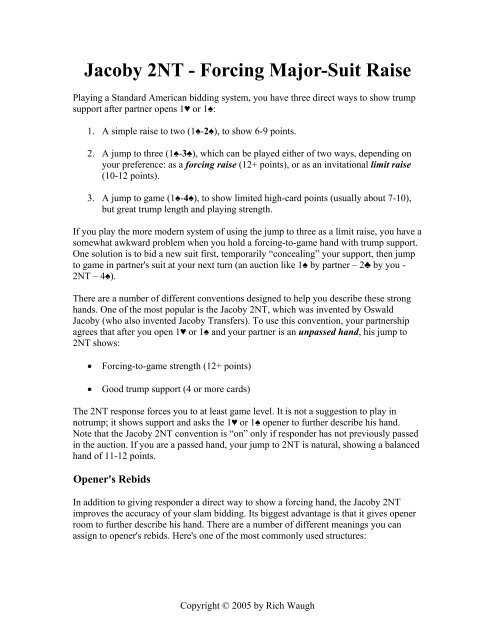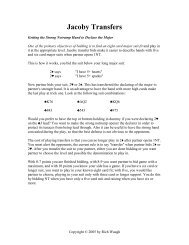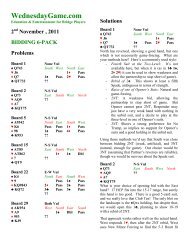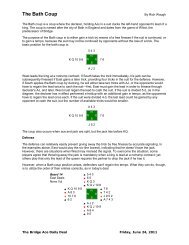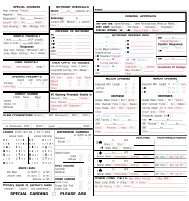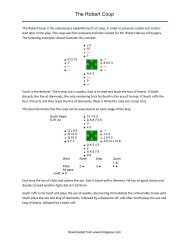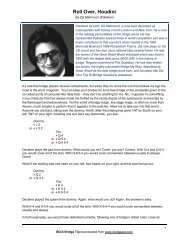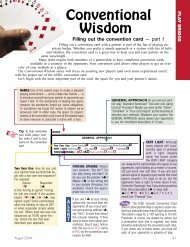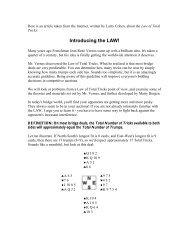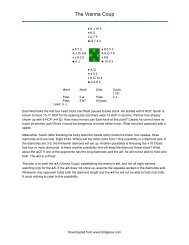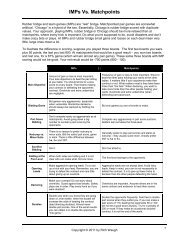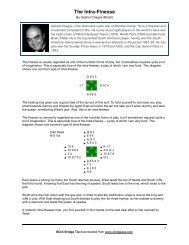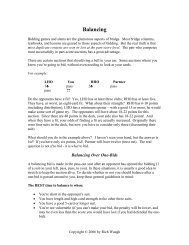Create successful ePaper yourself
Turn your PDF publications into a flip-book with our unique Google optimized e-Paper software.
<strong>Jacoby</strong> <strong>2NT</strong> - Forcing Major-Suit RaisePlaying a Standard American bidding system, you have three direct ways to show trumpsupport after partner opens 1♥ or 1♠:1. A simple raise to two (1♠-2♠), to show 6-9 points.2. A jump to three (1♠-3♠), which can be played either of two ways, depending onyour preference: as a forcing raise (12+ points), or as an invitational limit raise(10-12 points).3. A jump to game (1♠-4♠), to show limited high-card points (usually about 7-10),but great trump length and playing strength.If you play the more modern system of using the jump to three as a limit raise, you have asomewhat awkward problem when you hold a forcing-to-game hand with trump support.One solution is to bid a new suit first, temporarily “concealing” your support, then jumpto game in partner's suit at your next turn (an auction like 1♠ by partner – 2♣ by you -<strong>2NT</strong> – 4♠).There are a number of different conventions designed to help you describe these stronghands. One of the most popular is the <strong>Jacoby</strong> <strong>2NT</strong>, which was invented by Oswald<strong>Jacoby</strong> (who also invented <strong>Jacoby</strong> Transfers). To use this convention, your partnershipagrees that after you open 1♥ or 1♠ and your partner is an unpassed hand, his jump to<strong>2NT</strong> shows:• Forcing-to-game strength (12+ points)• Good trump support (4 or more cards)The <strong>2NT</strong> response forces you to at least game level. It is not a suggestion to play innotrump; it shows support and asks the 1♥ or 1♠ opener to further describe his hand.Note that the <strong>Jacoby</strong> <strong>2NT</strong> convention is “on” only if responder has not previously passedin the auction. If you are a passed hand, your jump to <strong>2NT</strong> is natural, showing a balancedhand of 11-12 points.Opener's RebidsIn addition to giving responder a direct way to show a forcing hand, the <strong>Jacoby</strong> <strong>2NT</strong>improves the accuracy of your slam bidding. Its biggest advantage is that it gives openerroom to further describe his hand. There are a number of different meanings you canassign to opener's rebids. Here's one of the most commonly used structures:Copyright © 2005 by Rich Waugh
If you open 1 of a major and partner responds <strong>2NT</strong>:• Your first obligation is to bid three of a suit where you have a singleton or void.• If you have a another semi-strong 5-card suit, show it by jumping to four of thesuit.• If you have extra values (but no singleton or void), describe your strength andpattern by rebidding 3NT with a fairly balanced hand or three of your suit withextra length (a 6+ card suit).• If you have a bare-minimum opener with no singleton or void, jump directly togame in your suit. This is your weakest rebid. It shows a fairly balanced handwith no interest in slam.For example, after you open 1♠ and partner responds <strong>2NT</strong>, the meanings of your rebidsare:• 3♣, 3♦ or 3♥ = Singleton or void in that suit.• 3♠ = 14+ points with extra length in your suit (or 19+ points if you're balanced),no singleton.• 3NT = 15-18 points, balanced, no singleton.• 4♣, 4♦, 4♥ = Good 5-card suit (QJxxx or better).• 4♠ = Minimum hand (12-14 points), no singleton.Once responder has this information, he can decide how to proceed. If he's not interestedin a slam, he can just jump to game. If he wants to explore further, he can cuebid a newsuit to show an ace. This requests opener to cuebid an ace.<strong>Jacoby</strong> <strong>2NT</strong> in action♠KJ832♥A65♦10♣A954Opener1♠3♦5♥♠A10764♥KQ5♦872♣K7Responder<strong>2NT</strong>4NT6♠Copyright © 2005 by Rich Waugh
After responder uses the <strong>Jacoby</strong> <strong>2NT</strong>, opener bids 3♦ to show his singleton. This isencouraging news for responder because it means his club and heart honors will fit wellin partner's hand. Knowing that his xxx suit is covered by opener's singleton -- and thatopener's outside strength is in clubs and/or hearts -- responder can use Blackwood tocheck on aces, and then bid his 24-point slam.Note that responder would evaluate his hand very differently if opener's answer to the<strong>Jacoby</strong> <strong>2NT</strong> had been 3♣ or 3♥. Singletons in these suits wouldn't be helpful becauseresponder's kings may well be “wasted” cards opposite the singleton. Over opener's 3♣rebid, responder would just jump to 4♠ to show that he no longer had interest in slam.♠QJ10543♥AKJ♦32♣K9Opener1♠3♠4♥♠AK72♥105♦KQ54♣A62Responder<strong>2NT</strong>4♣6♠Opener's 3♠ rebid denies a singleton, but promises a good (somewhat distributional)opener. Responder shows slam interest by cuebidding his club ace and opener cooperatesby cuebidding 4♥. This shows the heart ace and denies the diamond ace (since he'llcuebid his cheapest ace). Responder now knows that the partnership has extra values,control of every suit and exactly three aces. Since he doesn't need to use Blackwood, hejumps to 6♠.Copyright © 2005 by Rich Waugh


